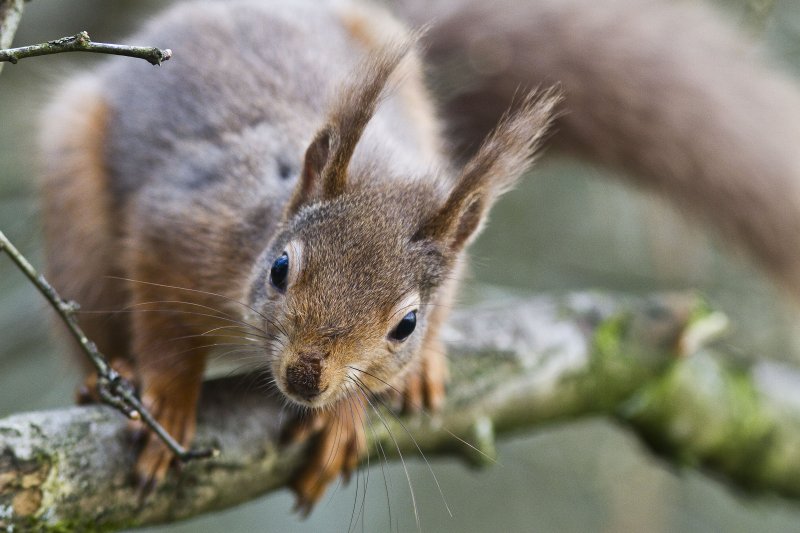Original Author: Dr Mel Tonkin, Project Manager
As we celebrate our 50th Anniversary, we have a golden opportunity to ensure that red squirrels remain an integral part of Scotland’s landscape for generations to come.
There’s no quick fix to the decline of native red squirrels in Scotland, a decline which goes back 150 years to the introduction of the larger non-native grey squirrel. Greys are able to outcompete reds for food and habitat and also carry squirrelpox – a virus lethal to reds but to which the greys are immune.
However, five years in, the Saving Scotland’s Red Squirrels project showed that – with sustained long-term effort – it is possible to reverse this decline and ensure that future generations will still have the chance to see this engaging species in the wild. We now have robust evidence that our strategy is working – the Saving Scotland’s Red Squirrels project is doing just what it says on the tin.
We are shortly due to publish a detailed report which details significant progress towards conserving red squirrel populations in Scotland.
Reds are returning…
Over 2013, the Trust analysed records collected by staff, landowners controlling grey squirrels, volunteers in our monitoring and trap-loan schemes and the general public. This data reveals that the collapse in Scottish red squirrel numbers has been halted and there are numerous examples of red squirrels returning to areas from which they had been absent for many years.
In Aberdeen, breeding red squirrels have been recorded in suburban gardens and are now seen regularly in parks that only a few years ago were overrun by grey squirrels. This red squirrel recovery is replicated in parts of Perthshire, Angus and northern parts of Stirling.
Greys are retreating…
Springtime surveys over several years show a trend of grey squirrel numbers dropping in several areas – sometimes dramatically so. We have seen a reduction in the spread of grey squirrels in rural Aberdeenshire and the disappearance of greys from the Strathyre area of Loch Lomond and the Trossachs.
Our data shows that if grey squirrel trapping is co-ordinated, systematic and sustained, it is possible to virtually eradicate grey squirrels from targeted areas. But the key word is sustained. If trapping is not maintained, re-invasions by grey squirrels will soon take the situation back to square one.

Squirrelpox – holding the line in southern Scotland
One aspiration of the Saving Scotland’s Red Squirrels project in southern Scotland has been to contain the spread of the squirrelpox virus and prevent it from reaching the uninfected grey squirrels of central Scotland. However, while it seems our project activities have considerably slowed the spread of the virus, it is still continuing to push slowly northwards.
However, more heartening news is that our data confirms that, as long as the number of greys in surrounding areas are kept at very low levels, red populations can recover from an outbreak of squirrelpox and go on to thrive. This is the case whether or not the surrounding greys carry the pox virus, and it provides an alternative way to sustain red squirrels in the south if we do not manage to halt the northwards spread of squirrelpox.
Other encouraging news in south Scotland came from the first ever surveys across the region, carried out in 2013. Far from hanging on by the skin of their teeth as many people thought, red squirrels were present in 58% of the surveyed areas, while greys were only detected in 25%. The reds are dominant in Dumfries and Galloway, south western parts of the Borders and South Ayrshire, while greys reign in the eastern Borders and across more northerly parts of the region. We will now apply this data to focus efforts even more effectively in the south.
What is certain is that red squirrel populations would not be in nearly such good shape without the Saving Scotland’s Red Squirrels project. The Scottish Wildlife Trust is committed to delivering this project in the long-term – it’s the only hope for our remaining red squirrel populations – and it’s vital not to lose momentum.
These inroads into red squirrel conservation could not have been made without the support of our members and their donations over the past five years. Now that we have firm evidence that this approach can work, please consider donating today to support our efforts in 2014 and beyond.
Your gift can help Save Scotland’s Red Squirrels
- £30 could pay for a bag of red squirrel feed
- £60 could pay for five squirrelpox tests
- £120 could pay for a camera trap to monitor squirrel populations
- £550 could pay for one week of expert advice and co-ordination for landowners and volunteers
Click here to donate to Saving Scotland’s Red Squirrels
